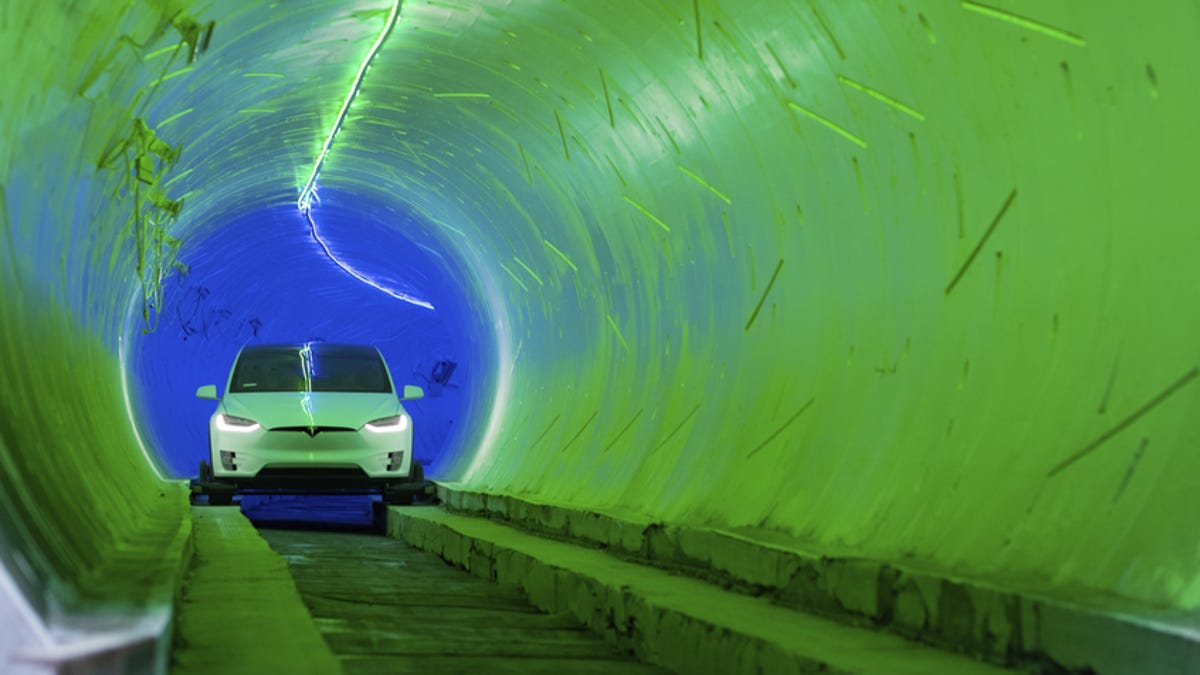Elon Musk unveils first Boring Company tunnel under SpaceX HQ
Where we're going, we won't need roads.

Two years ago, the relentless Los Angeles traffic frustrated Elon Musk so much he tweeted that he was going to build a tunneling machine to take transport subterranean, helping drivers beat the crazy backups altogether.
The Tesla and SpaceX CEO is known for making outlandish Twitter statements, but this time he wasn't joking. He was set on building a tunnel.
And lo, what seemed like a joke turned into a reality: In December 2016, The Boring Company was born.
On Tuesday, Musk officially opened the highly anticipated first Boring Company test tunnel under SpaceX headquarters in the Southern California city of Hawthorne, where The Boring Company is also located. Musk has slowly drip-fed information on the underground effort to the public on social media, but Tuesday marked a turning point as Boring's underground vision officially surfaced with not so much a party as a PowerPoint presentation.
Welcome to the tunnel.
Measuring 1.4 miles (2.3 kilometers) long and 14 feet (4.3 meters) wide, the test tunnel winds its way underneath Hawthorne and is estimated to have cost $10 million. This, Boring notes, is a fraction of the cost of traditional tunneling. It exists as a research and development tunnel for Boring's aspirations of improving tunneling capabilities and creating new modes of public transport.
The tunnel was originally designed to have the capability to transport vehicles on a pair of innovative electric skates that zip along at up to 150 mph (241 kph). However, that plan seems to have been given the kibosh for now, with Tesla vehicles that use "tracking wheels," rollers that flip out from underneath the front of the car and keep it within the tunnel's one-way lane.
Shortly before Tuesday's event, Musk tweeted an image of a Tesla Model X, on track, inside the tunnel, later clarifying that any autonomous electric vehicle, not just a Tesla, could use the system and that it would cost around $200 to $300 to install.
Tesla in @boringcompany tunnel with retractable wheel gear that turns a car into a rail-guided train & back again pic.twitter.com/3a6i0NoSmi
— Elon Musk (@elonmusk) December 19, 2018
Boring has also shown footage demonstrating that it can deliver cars from the test tunnel directly to a garage or parking lot using a lift system, which plucks vehicles from the tunnel and transports them above ground.
Several VIPs got to take rides on the newly opened track, with one reporter complaining of motion sickness. According to the Associated Press, Musk attributed the bumpy rides to the team running out of time and said the system will be "smooth as glass" when fully operational.
Tuesday's event took place next to a Monty Python-inspired medieval watchtower constructed from the excavated debris cast off by Boring Company's huge boring machine. Removing the dirt created by tunneling accounts for around 15 percent of the cost of boring holes.
"Instead of paying for the dirt to be trucked away from site, we convert the dirt into bricks," Musk said. "So we build bricks on site and then sell those bricks to whoever wants them."
At just 10 cents per brick, Boring suggests that this would pay for the cost of dirt removal and is a fraction of what you might pay at Home Depot. Musk also confirmed that Boring would attempt to make the bricks available for low-income housing for free.
Gary VI, the Boring Company's snail in his pineapple-shaped habitat.
The team jokingly tweeted that the tunnel opening, originally scheduled for Dec. 10, was pushed back because The Boring Company needed a few extra days to make the snail habitat for one of its unofficial mascots, Gary. Boring machines are notoriously slow -- a snail would be 14 times faster -- and one of the company's chief goals has always been to create a machine that can "beat the snail in a race." It doesn't appear that has come to fruition just yet.
"It's not easy beating that snail, by the way," Musk joked at a press briefing before Tuesday's tunnel opening. "It's much harder than it may seem." However, he did say he's confident that refining Boring's tunneling machine will eventually result in a 15-fold improvement to speed.
Take that, Gary.
The Boring Company has also landed a contract with the Chicago Infrastructure Trust to build the express loop system to Chicago's O'Hare International Airport.
In that version of the Loop, a modified Tesla X chassis will be used to ferry up to 16 passengers within a small pod running on the same electric skates. The service is expected to have pods leaving the station every 30 seconds and to be cheaper than a ride share service.
It doesn't stop in Chicago, either. Musk's plans for The Boring Company also extend across Los Angeles, with the goal of building a line from the western neighborhoods to Dodger Stadium, and a 35-mile line of twin tunnels from Washington, DC, to Maryland that would take passengers between the two stops in approximately 15 minutes.
CNET's Holiday Gift Guide: The place to find the best tech gifts for 2018.
Taking It to Extremes: Mix insane situations -- erupting volcanoes, nuclear meltdowns, 30-foot waves -- with everyday tech. Here's what happens.

